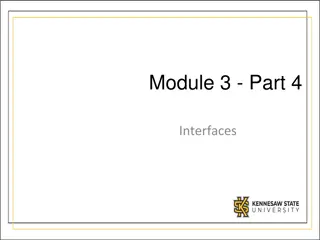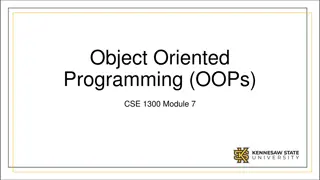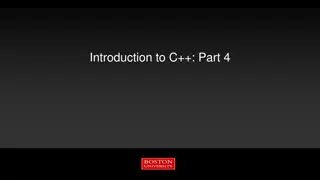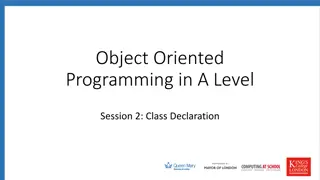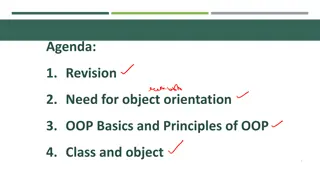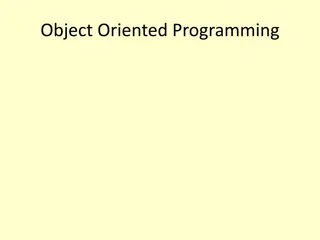
Functional Programming and OOP in Python
"Explore functional programming tools like lambda functions, filter, map, and reduce in Python, and learn about object-oriented programming concepts. Create a function to find the sum of prime numbers in two integer arguments. Python supports multiple paradigms, including OOP."
Download Presentation

Please find below an Image/Link to download the presentation.
The content on the website is provided AS IS for your information and personal use only. It may not be sold, licensed, or shared on other websites without obtaining consent from the author. If you encounter any issues during the download, it is possible that the publisher has removed the file from their server.
You are allowed to download the files provided on this website for personal or commercial use, subject to the condition that they are used lawfully. All files are the property of their respective owners.
The content on the website is provided AS IS for your information and personal use only. It may not be sold, licensed, or shared on other websites without obtaining consent from the author.
E N D
Presentation Transcript
LECTURE 4 FUNCTIONAL PROGRAMMING, AND OOP
Functional Programming Tools Python can support many different programming paradigms including functional programming. >>> def f(x): ... return x**2 ... >>> print (f(8)) 64 >>> g = lambda x: x**2 >>> print (g(8)) Lambda functions within Python. o Use the keyword lambda instead of def. o Can be used wherever function objects are used. o Restricted to one expression. o Typically used with functional programming tools >>> g = lambda x, y: x + y >>> print(g(10, 20))
Functional Programming Tools Filter def even(x): if x % 2 == 0: return True else: return False o filter(function, sequence) filters items from sequence for which function(item) is true. o Returns a string or tuple if sequence is one of those types, otherwise result is a list. print(list(filter(even, range(0,30)))) [0, 2, 4, 6, 8, 10, 12, 14, 16, 18, 20, 22, 24, 26, 28]
Functional Programming Tools Map o map(function, sequence) applies function to each item in sequence and returns the results as a list. o Multiple arguments can be provided if the function supports it. def expo(x, y): return x**y print(list(map(expo, range(1,5), range(1,5))))) [1, 4, 27, 256]
Functional Programming Tools Reduce o Defined in functools module o reduce(function, sequence) returns a single value computed as the result of performing function on the first two items, then on the result with the next item, etc. o There s an optional third argument which is the starting value. import functools def fact(x, y): return x*y print(functools.reduce(fact, range(1,5))) 24
Functional Programming Tools Small user defined function to be applied to the whole array lambda function >>> print(list(map(lambda x: x**2, range(0,11)))) [0, 1, 4, 9, 16, 25, 36, 49, 64, 81, 100]
Exercise Write a function that takes two integer arguments and returns the sum of all prime numbers in the two arguments (assume isPrime(x) function is available)
Object-Oriented Programming in Python Python is a multi-paradigm language and, as such, supports OOP as well as a variety of other paradigms. If you are familiar with OOP in C++, for example, it should be very easy for you to pick up the ideas behind Python s class structures.
Class Definition Classes are defined using the class keyword with a very familiar structure: class ClassName : statement1 statementN There is no notion of a header file to include so we don t need to break up the creation of a class into declaration and definition. We just declare and use it!
Class Object Class example and its use. class MyClass: """"A simple example class docstring""" i = 12345 # this is a class variable (static variable) def f(self): return MyClass.i Create a new instance of MyClass x = MyClass() print(x.f) See lect4/class1.py
Constructor Define the special method __init__() which is automatically invoked for new instances (initializer). class MyClass: """A simple example class"" i = 12345 def __init__(self): print "I just created a MyClass object!" def f(self): return 'hello world'
Constructor Variables defined outside of __init__() are class variables Variables defined inside __init__() are elements of the object class MyClass: """A simple example class"" i = 12345 # this is a class variable def __init__(self): self.j = 10 # an element of the object self.k = 20 # an element of the object def f(self): return self.k See lect4/class2.py
Data Attributes Like local variables in Python, there is no need for a data attribute to be declared before use. A variable created in a class is a static variable. To make instance variables, they need to be prefixed with self . This is especially evident with mutable attributes. There are also some built-in functions we can use to accomplish the same tasks.
Built-in attributes Besides the class and instance attributes, every class has access to the following: o __dict__: dictionary containing the object s namespace. o __doc__: class documentation string or None if undefined. o __name__: class name. o __module__: module name in which the class is defined. This attribute is "__main__" in interactive mode. o __bases__: a possibly empty tuple containing the base classes, in the order of their occurrence in the base class list. See lect4/class2_n.py
Private Variables No mechanism to distinguish private and public variables in the language Achieve the same goal by naming convention o If an attribute is prefixed with a single underscore (e.g. _name), then it should be treated as private. Basically, using it should be considered bad form as it is an implementation detail. o To avoid complications that arise from overriding attributes, Python does perform name mangling. Any attribute prefixed with two underscores (e.g. __name) and no more than one trailing underscore is automatically replaced with _classname__name.
Inheritence The basic format of a derived class is as follows: class DerivedClassName(BaseClassName): statement1 ... statementN In the case of BaseClass being defined elsewhere, you can use module_name.BaseClassName. See lect4/class3.py



